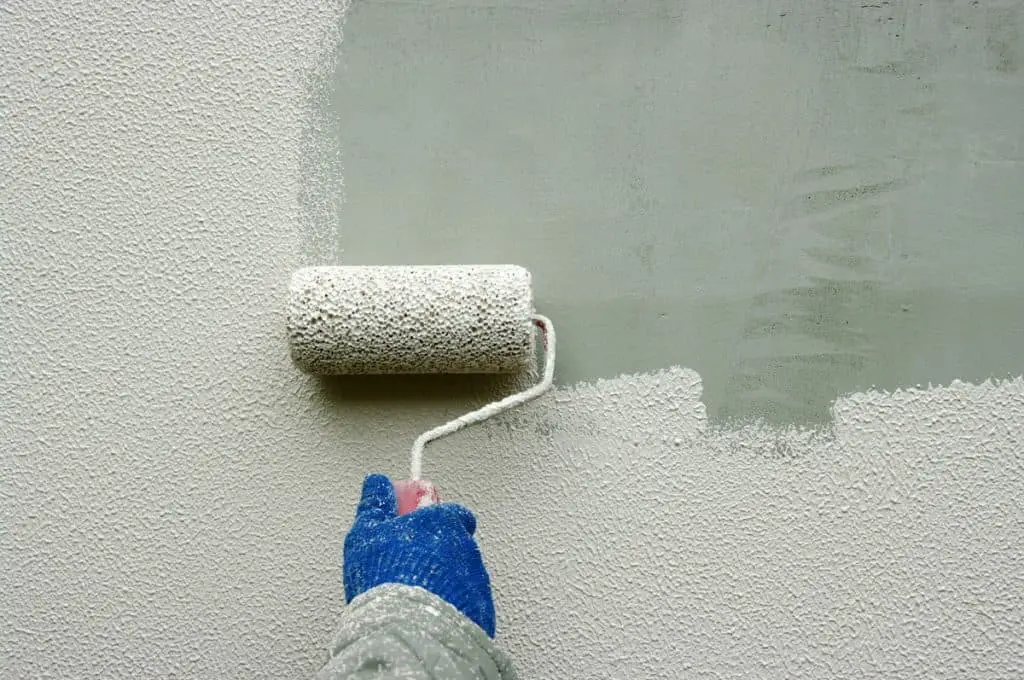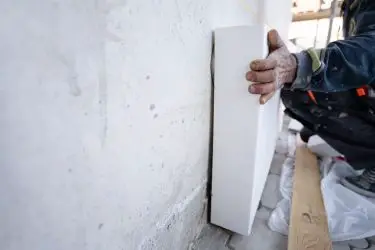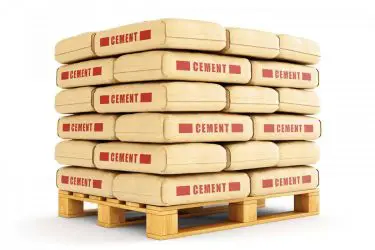Slapping on a coat of paint here and there sounds like an easy task, and while it at times it can be, it is important to prepare for your specific situation. Concrete walls are known for holding in moisture and sucking up the paint put on the surface. If done right, paint can last a long time on concrete walls and add to the beauty of your home.
In a series of steps, a beautifully painted concrete surface will be yours. Preparation is key to the life and durability of your paint on concrete. Clean the surface off, apply some sealant and primer, and then roll your paint on!

Table of Contents
1. Clean, Strip, And Sand The Surface
A good deal of preparation needs to go into painting a concrete wall, and preparation will be the difference between lasting paint and paint that flakes off in under a year.
There are multiple ways to prepare including, checking for water damage, cleaning the area, removing, or covering furniture, stripping off old paint, and sealing cracks.
Check For Water Damage
Before even beginning to take the first steps in painting, be sure to get a feel for the condition of your surface, especially if it is basement walls.
Walls in the basement are very different from walls throughout the house because they are more prone to absorbing water from the ground, and they are serving not only as walls but as a foundation.
Feel the walls in multiple areas to see if your walls are moist or damp, as this will cause the paint to decay much faster and should be taken care of.
Also, be sure there are no water leaks. If so, be sure to get them fixed completely before beginning. Many people paint basements simply to keep water leaks to a minimum, but for the paint and sealer to do their job, it must be laid on a dry surface.
Related article: How to Cover Concrete Walls in a Basement
Clean The Area
Move all the furniture to another room or move it to the center and lay down a cloth or sheet over the floor to keep it from getting drops of paint.
If you are not painting a basement, remove anything near the site of paint, and prepare with a sheet of tape over the places paint is not needed. Hopefully, you can make all walls available and clear to walk around the room.
If you are painting your basement, you might want to check out our article on how to clean concrete basement walls before you start the painting process.
After you have completed all processes for preparing the area, go back through the room and wipe all surfaces free of dust and other debris gathered from the preparation process.
Strip Off Old Paint
If the concrete wall in your home is bare, or the paint is pretty much gone, you are likely able to skip this step.
Leftover paint still stuck to the surface of the concrete will allow your new paint to come off quickly and be bumpy. Using a paint scraper or a wire brush of some sort, scrub the walls.
If there is paint that has stained the concrete, you can paint over it and be fine, but paint that is on the surface and flaking must be removed. Get off as much as you can!
Related article: 10 Best Ways To Remove Paint From Concrete Floors
Sand And Fill Cracks
In addition to getting off old paint, sanding can be done to refine the concrete surface. As a matter of fact, even if your surface is currently not painted, you should sand the surface.
Doing it over and over 3 or 4 times will be beneficial. Sand with a fine-grit sandpaper and use circular motions. Do not forget any portion of the concrete as paint sticks much better to a flat surface.
This will create dust that will afterward need to be cleaned up as well.
If there are cracks or holes in the concrete, it is best to fill them before you even begin painting. Sand them off and fill in the cracks using the cement of your choice.
After you have filled the cracks as well as you can, smooth off any excess cement, making it a soft surface also. Wait for about 24 hours before you come back to the project. Upon returning, sand the spots you repaired.

2. Apply Sealant And Primer
The reason for the sealant is to keep the water out of the paint and to give the paint more of a surface to stick to.
As previously mentioned, basement walls will often absorb water, which causes cracks, mold, or a variety of other problems. Sealant penetrates the concrete pores and protects them from water damage.
There are many types of sealants available, but if you are doing a basement wall, a waterproof sealant would be best.
Read more: 11 Best Concrete Sealers (and a few mistakes to avoid)
The purpose of a primer is similar. It gives you a flat and consistent surface to paint on and fills in all the small holes and cracks existent in your concrete surface.
It will also absorb into the concrete and enhance the life of your concrete and paint. Overall, it will turn a poor painting surface into a great one!
Tape Edges
There are probably windows, doors, and baseboards that will all need protection from the paint and sealers, so be sure to tape off the edges of each of these.
Also, tape down the edges of a drop cloth or plastic sheet to ensure it does not come up. Before you start with all these chemicals and smells it will also be a good protective measure to open the windows and pull out your safety gear.
Seal Concrete
Depending upon the color of your paint, you will want a dark, white, or clear sealant. Grab the tools you will need, like a paint roller, paintbrushes, and a paint tray.
It would also be helpful to have a ladder to get to all edges of the wall. Also, get a couple of gallons of sealant. Once you have it, be sure to follow all instructions on the bag to mix and prepare the sealant to be painted on your concrete surface.
Then, roll the sealant evenly on the whole of the surface, being sure to get it in the cracks and edges.
Running over the entire surface 2 or 3 times will ensure the sealant gets into all the cracks and crevices. The instructions for the specific brand of sealant can give you the exact drying time, but it’s suggested to wait 24 to 72 hours before painting or priming, which will give the sealant time to soak in and dry.
Prime Concrete
Priming and sealing concrete go hand in hand, but doing both is not always necessary. To ensure the possible adhesion of your paint to the wall, apply both. The same rules and instructions for sealant happen with primer. Roll it on the surface and in the cracks and give it time to dry.
Read more: Priming Concrete Before Painting: Is it necessary?
When buying both primer and sealant, be sure you are getting the correct one. Either the interior or exterior type will work.
Primer normally takes about 2 hours to dry but wait about 8 hours. If you plan to wait longer, be sure that you do not wait to apply paint over 30 days after you have applied the primer. Read instructions and allow both primer and sealant ample time to dry before applying any paint.
After you have cleaned and sanded the walls, applied the sealant and paint, and allowed it to dry, you must sand over it one more time! This will ensure that it is a smooth surface that the paint will stick to.
3. Paint The Concrete
Finally, we get to the actual painting of the wall. While it takes lots of preparation, it will pay off when your painted concrete wall lasts you for years to come and aids in the feel of your basement or other concrete surfaces.
Grab your roller and paint tray and begin to roll the paint evenly onto the walls or other concrete surface.
If it is your basement wall, paint the bulk of the surface first, leaving 3 to 6 inches of space between where you paint and the edges of the walls and windows, and later go back to touch these up.
Do it slowly, applying a good amount of pressure to help with the adhesion.
After waiting about 2 or 3 days for your first coat to dry, apply a second coat of paint following the same pattern. Start in the middle and work your way to the edges. Be sure it follows the pattern you wish as that is what you will be seeing for the next couple of years, or even longer if the process went well.
After you have waited for 24 to 48 hours for the wall to dry completely, cleanup is imminent. Be sure to dust or vacuum so that dust doesn’t stick to the wet paint and wait 3 days to touch the wall.




